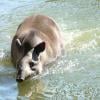The tapir is related to the horse and rhinoceros. Today’s tapirs closely resemble those found roaming the Earth 35 million years ago. The Brazilian or Lowland Tapir is nearly always found close to water and is an excellent swimmer. It is fast and sure-footed on land too, even on the roughest terrain.
Tapirs are blackish brown and can grow to a length of 5 feet (1.6 metres) and shoulder height of 3 feet (90cm), and weighs about 595 pounds (270 kilos). The most distinguishable feature of tapirs is their long flexible snout which resembles a short trunk. They can use this snout to pluck fruit, strip leaves off branches and as a snorkel when swimming. Tapirs are most active at night (nocturnal).
The tapir is solitary by nature, no more than three are ever seen together. The tapir’s streamlined shape makes it ideal for pushing through the dense forest undergrowth of South America. Tapirs usually give birth to a single baby after 13 months’ gestation. The newborn has a reddish brown coat dappled with spots and stripes. This is a form of camouflage to help protect the youngster for the first 6 months of their life. After 7 months the calf becomes increasingly independent from its mother.
ConservationStatus
Least Concerned
Near Threatened
Vulnerable
Endangered
Critically Endangered
Extinct In The Wild



